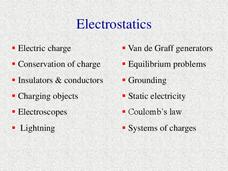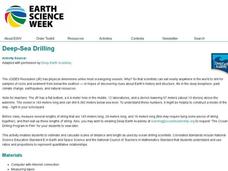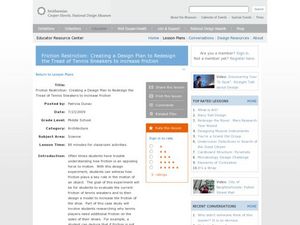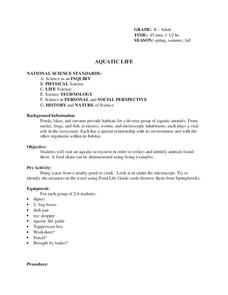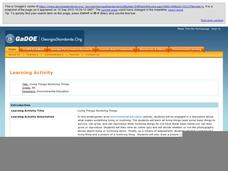Urbana School District
Electrostatics
Why did lightning shock the man? Because it didn't know how to conduct itself. Presentation covers electric charges, insulators, conductors, electroscopes, lightning, generators, grounding, static electricity, and more. Presentation...
Urbana School District
Magnetism
The compass was first used in 206 B.C., but we didn't discover magnetic poles until 1263 A.D. Presentation begins with the history of magnetism before continuing on to magnetic fields, magnetic forces, electromagnets, currents,...
American Museum of Natural History
Light Quest
Grab a partner and shed some light on light. A remote learning resource has scholars play a board game to answer trivia questions about light. They also read about how Einstein contributed to the understanding of light as both a wave and...
Curated OER
"Water is Life" Global Water Awareness
Students examine and calculate the percentage of potable water remaining on the earth. In this ecology and geography lesson, students brainstorm the main factors affecting water distribution. Students use mathematical problem solving to...
Curated OER
Old Solutions - New Solutions
Students examine descriptions of a mining company's land-reclamation project. They share information to analyze the environmental impact of the project. Independently, they answer questions on environmental and economic issues...
Curated OER
In the Mix
Students construct a water filter. In this engineering lesson, students discover how to construct a water filtration system. Students work in groups to sort tools by their properties. Students analyze and construct a water filtration...
Curated OER
Recycle Lifecycle
Students investigate the recycling process. For this recycling lesson, students read the article The Recycling Process After Collection and discuss the advantages of recycling. As an extension activity, students simulate the molding of...
Curated OER
Science: Wind Power
Students build models of wind turbines and experiment with different designs that will improve efficiency. Students will understand the use of wind power as a renewable resource.
Curated OER
Deep Sea Drilling
Young scholars explore ocean vessels that drill the ocean floor. In this ocean drilling lesson, students watch videos about drilling the ocean floor and discuss. Young scholars get into groups, go outside and use string to mark...
Curated OER
Chemical Composition of American Coins
Students investigate the chemical composition of pennies dated 1983 or later. In this chemical composition of American coins lesson plan, students scratch the surface of the penny to expose the zinc core. They put the penny in...
Curated OER
Aristotelian and Newtonian Motion
Students use a quotation from Einstein as a reference to categorize their descriptions as either Newtonian or Aristotelian. They discuss the idealized nature of the Newtonian approach. Students describe the events they observe when an...
Curated OER
Observation Hike
Students participate in an observational hike to study the natural surroundings. In this observational hike lesson, students hike through a state park and observe the plant and animal life. Students learn about appropriate...
Curated OER
Hero Or Zero?
Students investigate science and technology by reading a children's book. In this reading comprehension lesson, students read the story Archibald Frisby and discuss the ways we use science and technology in everyday life....
Curated OER
Friction Restriction: Creating a Design Plan to Redesign the Tread of Tennis Sneakers to Increase Friction
Young scholars evaluate the friction of tennis sneakers and redesign them to increase friction. For this physics lesson, students calculate starting, sideways and forward stopping friction. Using quantitative data, they prove that...
Curated OER
Biodiesel Combustion and Its Influences in NOx Emissions
Tenth graders evaluate the physical mechanisms that cause a change in NOx emissions. In this combustion lesson, 10th graders participate in a research project. Students create a presentation of their findings.
Curated OER
Atlatl (Native Americans)
Learners discover what an atlatl is and how to use it. In this Native American lesson, students discuss the history of the Native American atlatl and practice throwing with it. Learners will analyze the effects of the atlatl in terms of...
Curated OER
Aquatic Life
Learners explore aquatic life. In this science lesson, students visit an aquatic ecosystem and collect animals found there. Learners create a food chain for the aquatic ecosystem.
Curated OER
Basic Orienteering
Students study orienteering. In this science lesson, students study the parts of a compass and use the compass to set a bearing and follow the bearing on the compass.
Curated OER
Chucky Chickadee: Bird and Breakfast Meet the Winter Friends
Students compare and contrast the attributes of winter birds. In this winter bird lesson, students examine the physical attributes of Black-capped Chickadees, Cardinals, Blue Jays, Flickers, Juncos, Nuthatches, and Tufted Titmouses as...
Curated OER
Sugar Bush Sap Production - Human Environmental Impact on Sap Sand
Eleventh graders compare the amount of sugar sand present in tree sap. In this environmental science lesson, 11th graders measure different tree circumference. They prepare a report and share findings in class.
Curated OER
Indiana Tornado Project
High schoolers become familiar with the use of GIS for research, natural phenomena in Indiana, and analyzing collected information.
Curated OER
Bottle Rocket Lesson
Students design a rocket that stays on air for the longest period of time. In this physics lesson, students research the function of different rocket components. They test their design and make necessary modifications.
Georgia Department of Education
Living Things/ Nonliving Things
How can you tell if something is living or nonliving? Introduce a set of criteria which can be used to determine which things are alive and which are not. The class discusses the basic needs of all living organisms, checks out an...
Curated OER
Eggs'ceptional Experiments
Students see evidence of chemical reaction and follow the scientific method to hypothesize, observe, and reach conclusions. They conduct a series of egg based experiments such as forming crystals and complete journal activities as a...


